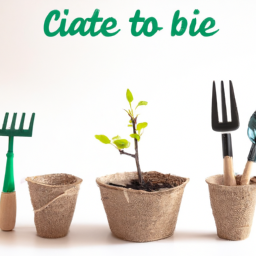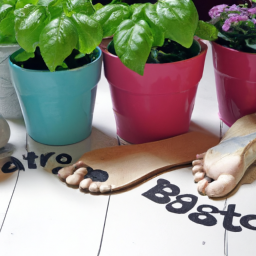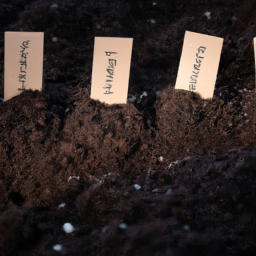
Are you looking to create a thriving garden while also doing your part to protect the Earth? Look no further than sustainable soil! In this blog post, we will explore the importance of sustainable soil and how it can nurture both your garden and the planet. By understanding the benefits of sustainable soil practices, you can cultivate a garden that not only flourishes but also contributes to the overall health of our environment. So, let’s dive in and discover the wonders of sustainable soil: nurturing your garden and the Earth.
The Importance of Sustainable Soil in Gardening: Exploring the Benefits for Your Garden and the Environment
Gardening is not just a hobby or a way to beautify our surroundings; it is also a means to connect with nature and contribute positively to the environment. One crucial aspect of gardening that often goes unnoticed is the importance of sustainable soil. Sustainable soil is the foundation upon which a thriving garden can be built, and it plays a significant role in promoting healthy plant growth, biodiversity, and environmental sustainability. In this article, we will explore the benefits of sustainable soil for your garden and the environment, and provide you with a step-by-step guide on nurturing your garden and the earth.
The Benefits of Sustainable Soil
Sustainable soil is a key component of sustainable gardening practices, and it offers a multitude of benefits for both your garden and the environment. Let’s delve into some of the significant advantages:
1. Enhanced Nutrient Availability: Sustainable soil is rich in organic matter, which serves as a nutrient reservoir for plants. It improves nutrient availability, ensuring that your plants receive the essential elements they need to thrive. Additionally, sustainable soil retains nutrients for longer periods, reducing the need for frequent fertilization.
2. Improved Water Retention: Sustainable soil has excellent water-holding capacity, allowing it to retain moisture for longer periods. This characteristic is particularly beneficial in areas with limited water availability or during dry spells. By retaining water, sustainable soil helps reduce irrigation needs and conserves this precious resource.
3. Enhanced Soil Structure: Sustainable soil is well-structured, with a balanced composition of sand, silt, and clay particles. This optimal structure promotes good drainage, preventing waterlogging and root rot. It also allows for better root penetration and aeration, facilitating healthy root development and overall plant growth.
4. Increased Biodiversity: Sustainable soil fosters a thriving ecosystem beneath the surface. It provides habitat and nourishment for beneficial soil organisms such as earthworms, bacteria, fungi, and insects. These organisms contribute to nutrient cycling, decomposition of organic matter, and the suppression of harmful pests and diseases.
5. Carbon Sequestration: Sustainable soil plays a crucial role in mitigating climate change by acting as a carbon sink. It stores carbon dioxide from the atmosphere and converts it into organic matter, locking it away in the soil for the long term. This process helps reduce greenhouse gas emissions and combat global warming.
Nurturing Your Garden and the Earth: A Step-by-Step Guide
Now that we understand the importance and benefits of sustainable soil, let’s dive into a step-by-step guide on how to nurture your garden and the earth:
Step 1: Assess Your Soil: Start by assessing the quality of your soil. Perform a soil test to determine its pH level, nutrient content, and composition. This information will guide you in making necessary amendments and adjustments to create a sustainable soil environment.
Step 2: Add Organic Matter: Sustainable soil thrives on organic matter. Incorporate compost, leaf litter, grass clippings, or well-rotted manure into your soil. These organic materials enrich the soil with essential nutrients, improve its structure, and enhance its water-holding capacity.
Step 3: Practice Crop Rotation: To maintain soil health and prevent nutrient depletion, practice crop rotation. Rotate your crops each season, planting different types of plants in different areas of your garden. This practice helps break pest and disease cycles and ensures a balanced nutrient uptake by varying plant species.
Step 4: Mulch Your Garden: Mulching is an effective technique to conserve moisture, suppress weeds, and regulate soil temperature. Apply a layer of organic mulch such as wood chips, straw, or shredded leaves around your plants. This protective layer also decomposes over time, adding organic matter to the soil.
Step 5: Minimize Chemical Inputs: Reduce or eliminate the use of synthetic fertilizers, herbicides, and pesticides in your garden. These chemicals can disrupt the delicate balance of sustainable soil and harm beneficial soil organisms. Instead, opt for organic and natural alternatives to maintain a healthy and thriving ecosystem.
Step 6: Practice Water Conservation: Efficient water management is vital for sustainable gardening. Water your plants deeply but infrequently to encourage deep root growth. Consider collecting rainwater or using drip irrigation systems to minimize water waste. Avoid overwatering, as it can lead to waterlogging and nutrient leaching.
Step 7: Encourage Biodiversity: Foster biodiversity in your garden by planting a variety of native plants. Native plants are well-adapted to the local soil and climate conditions, requiring less maintenance and inputs. Additionally, provide habitat for beneficial insects and wildlife by incorporating features like bird feeders, bee hotels, and butterfly gardens.
Step 8: Monitor and Adapt: Regularly monitor the health of your plants and soil. Look for signs of nutrient deficiencies, pest infestations, or soil erosion. Adjust your gardening practices accordingly, making necessary amendments or seeking expert advice to address any issues that arise.
By following these steps and nurturing sustainable soil, you can create a thriving garden that not only beautifies your surroundings but also contributes to the health of the earth. Remember, sustainable gardening is a continuous process that requires patience, observation, and a deep respect for the interconnectedness of all living beings.
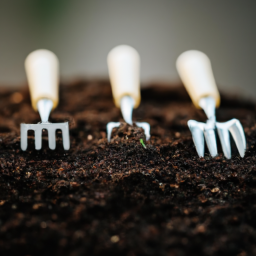
Implementing Sustainable Soil Practices: Tips and Techniques for Nurturing Healthy Gardens and Protecting the Earth
When it comes to gardening, sustainable soil practices are essential for nurturing healthy plants and protecting the Earth. By adopting techniques that promote soil health and minimize environmental impact, gardeners can create thriving gardens while reducing their carbon footprint. In this article, we will explore the step-by-step guide to implementing sustainable soil practices that will not only benefit your garden but also contribute to a greener planet.
Understanding the Importance of Sustainable Soil Practices
Before diving into the practical tips, it’s crucial to grasp why sustainable soil practices are vital for the health of your garden and the Earth. Soil is a living ecosystem that supports the growth of plants by providing essential nutrients, water, and a stable foundation for their roots. However, conventional gardening practices often degrade soil quality through the excessive use of chemical fertilizers, pesticides, and tilling.
Implementing sustainable soil practices helps restore soil health and fertility, leading to improved plant growth and resilience. Additionally, these practices minimize the negative impact on the environment by reducing water pollution, conserving resources, and promoting biodiversity. By nurturing the soil, you are not only benefiting your garden but also contributing to a sustainable future.
Now, let’s delve into the step-by-step guide to implementing sustainable soil practices in your garden:
1. Building Healthy Soil through Composting
Composting is a fundamental technique for creating nutrient-rich soil that supports plant growth. It involves the decomposition of organic materials, such as kitchen scraps, yard waste, and leaves, into a dark, crumbly substance known as compost. Compost improves soil structure, enhances water retention, and provides a slow-release source of nutrients for plants.
To start composting, designate an area in your garden for a compost pile or invest in a compost bin. Add a mix of “green” materials (e.g., fruit and vegetable scraps, coffee grounds) and “brown” materials (e.g., dried leaves, straw) to the pile. Turn the pile regularly to aerate it and speed up the decomposition process. Within a few months, you’ll have nutrient-rich compost ready to be incorporated into your garden beds.
By composting, you not only reduce waste that would otherwise end up in landfills but also minimize the need for synthetic fertilizers, reducing their environmental impact.
2. Embracing Organic Fertilizers and Soil Amendments
When it comes to nourishing your garden, organic fertilizers and soil amendments are the way to go. Unlike synthetic fertilizers, which can harm beneficial soil organisms and leach into waterways, organic options are derived from natural sources and support a healthy soil ecosystem.
One popular organic fertilizer is compost tea, which is created by steeping compost in water. This nutrient-rich liquid can be applied directly to plants or used to water the garden. Other organic options include manure, bone meal, and seaweed extracts. These fertilizers provide a slow-release of nutrients and improve soil structure, promoting healthier plant growth.
Soil amendments such as vermicompost (worm castings), biochar, and rock dust can also be beneficial. They enhance soil fertility, improve water-holding capacity, and provide essential minerals to plants. Incorporating these organic fertilizers and amendments into your garden helps maintain soil health while minimizing the use of synthetic chemicals.
3. Practicing Mulching for Soil Conservation
Mulching is a simple yet effective technique for conserving soil moisture, suppressing weeds, and improving overall soil health. By covering the soil surface with a layer of organic matter, such as straw, wood chips, or leaves, you create a protective barrier that helps retain moisture and regulate soil temperature.
When applying mulch, ensure a layer around 2-4 inches thick. This will prevent weed growth by blocking sunlight, reducing the need for herbicides. Mulch also acts as a natural weed suppressant by smothering any existing weeds. As the organic matter breaks down, it enriches the soil with nutrients and organic content, enhancing its fertility.
Furthermore, mulching reduces evaporation, conserving water and promoting a more sustainable use of this precious resource. It also prevents soil erosion by protecting the soil from heavy rain and wind, ensuring your garden remains intact and productive.
Conclusion
Implementing sustainable soil practices is not only beneficial for your garden but also plays a crucial role in protecting the Earth. By building healthy soil through composting, embracing organic fertilizers and soil amendments, and practicing mulching, you can nurture your garden while minimizing environmental impact. These techniques enhance soil fertility, conserve resources, reduce pollution, and promote biodiversity. So, let’s take the step towards sustainable gardening practices and contribute to a greener future.
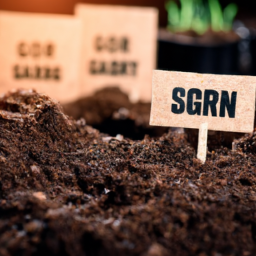
Understanding the Role of Sustainable Soil Management in Promoting Biodiversity and Conservation Efforts
The Importance of Sustainable Soil Management
Soil is not just a mere medium for plants to grow; it is a complex ecosystem that supports life on Earth. Sustainable soil management plays a crucial role in promoting biodiversity and conservation efforts. By nurturing our garden soil in a sustainable manner, we can create a thriving environment that benefits both the plants and the Earth.
1. Building Healthy Soil
The first step towards sustainable soil management is building healthy soil. Healthy soil is rich in organic matter, teeming with beneficial microorganisms, and has a well-balanced nutrient profile. To achieve this, consider the following practices:
Compost and Organic Matter
Adding compost and organic matter to your soil is like giving it a nutritious meal. Compost improves soil structure, enhances water retention, and provides essential nutrients for plants. It also acts as a habitat for beneficial soil organisms, such as earthworms and bacteria, which contribute to the overall health of the soil.
Reducing Chemical Inputs
Chemical fertilizers and pesticides can harm not only the plants but also the soil ecosystem. Aim to reduce or eliminate the use of synthetic chemicals in your garden. Instead, opt for organic fertilizers and natural pest control methods. This helps maintain a healthy balance of nutrients and prevents the accumulation of harmful chemicals in the soil.
Crop Rotation and Cover Crops
Practicing crop rotation and using cover crops are effective ways to prevent soil erosion, control pests and diseases, and improve soil fertility. Crop rotation involves growing different types of plants in a specific sequence, which helps break pest cycles and replenish soil nutrients. Cover crops, such as legumes or grasses, protect the soil from erosion, fix nitrogen, and add organic matter when incorporated.
2. Conserving Soil Moisture
Conserving soil moisture is essential for sustainable soil management, especially in regions prone to drought or water scarcity. Here are some techniques to help retain moisture in the soil:
Mulching
Mulching is the practice of covering the soil surface with a layer of organic material, such as straw, leaves, or wood chips. Mulch acts as a protective barrier, reducing evaporation and preventing weed growth. It also helps regulate soil temperature and improves water infiltration, keeping the soil moist for longer periods.
Watering Techniques
When watering your garden, opt for techniques that minimize water loss. Drip irrigation systems deliver water directly to the plant roots, reducing evaporation and ensuring efficient water use. Another method is using soaker hoses, which release water slowly and evenly along the plant rows, allowing it to penetrate deeply into the soil.
Conservation Tillage
Traditional tilling practices can disrupt the soil structure and lead to moisture loss. Conservation tillage techniques, such as no-till or reduced tillage, minimize soil disturbance and help retain moisture. Leaving crop residues on the soil surface acts as a protective layer, reducing evaporation and erosion.
3. Promoting Biodiversity in the Soil
Biodiversity in the soil is crucial for its long-term sustainability. A diverse soil ecosystem supports a wide range of beneficial organisms, such as earthworms, fungi, and bacteria, which contribute to nutrient cycling, disease suppression, and soil structure improvement. Here’s how you can promote biodiversity in your garden soil:
Plant Diversity
Plant a variety of plants in your garden to attract different types of beneficial organisms. Each plant species has a unique root structure and releases specific compounds into the soil, creating a diverse habitat for soil life. Consider incorporating flowers, herbs, and native plants to attract pollinators and beneficial insects.
Minimize Soil Disturbance
Excessive soil disturbance, such as frequent tilling or overuse of heavy machinery, can harm soil organisms and disrupt their habitats. Minimize soil disturbance by adopting no-till or reduced tillage practices. Additionally, avoid compacting the soil by walking or driving on it when it is wet, as compaction reduces the availability of oxygen and restricts root growth.
Add Beneficial Organisms
Introduce beneficial organisms, such as earthworms or mycorrhizal fungi, to your garden soil. Earthworms enhance soil structure, increase nutrient availability, and aid in decomposition. Mycorrhizal fungi form symbiotic relationships with plant roots, improving nutrient uptake and enhancing plant resilience. You can purchase these organisms from specialized suppliers or create conditions that naturally attract them.
By implementing sustainable soil management practices, you not only nurture your garden but also contribute to the conservation of our planet. Healthy soil promotes plant growth, reduces the need for synthetic inputs, conserves water, and supports a diverse range of organisms. Embrace the power of sustainable soil management and be a steward of the Earth’s precious resources.
Key Takeaways of this article
Are you an avid gardener looking for ways to make your garden more sustainable? Look no further! In this blog post, we will delve into the importance of sustainable soil and how it can benefit not only your garden but also the environment.
Sustainable soil is all about nurturing the earth and fostering a healthy ecosystem in your garden. It involves practices that help maintain the fertility of the soil and minimize the use of harmful chemicals. By implementing sustainable soil practices, you can improve the health of your plants, reduce water usage, and even combat climate change. From composting and mulching to crop rotation and cover cropping, there are various techniques you can adopt to promote sustainable soil. So, let’s explore these methods and learn how to create a thriving garden while protecting the earth’s precious resources.
Frequently Asked Questions (FAQ):
Q1: What is sustainable soil and why is it important for gardening?
A1: Sustainable soil refers to soil that is able to support long-term plant growth without degrading its natural resources. It is important for gardening because it promotes healthy plant growth, improves water and nutrient retention, reduces the need for chemical fertilizers, and helps prevent soil erosion.
Q2: How can I nurture sustainable soil in my garden?
A2: To nurture sustainable soil in your garden, you can start by adding organic matter such as compost or aged manure to improve soil structure and fertility. Avoid over-tilling the soil, as it can disrupt the natural ecosystem. Use mulch to conserve moisture and prevent weed growth. Practice crop rotation to prevent nutrient depletion and reduce the risk of pests and diseases.
Q3: What are the benefits of using organic fertilizers instead of synthetic ones?
A3: Organic fertilizers, such as compost or worm castings, provide nutrients to plants in a slow-release form, which reduces the risk of nutrient runoff and leaching. They also improve soil structure, increase microbial activity, and promote beneficial organisms like earthworms. Additionally, organic fertilizers are environmentally friendly and do not contribute to water pollution or harm beneficial insects and wildlife.
Q4: How can I prevent soil erosion in my garden?
A4: To prevent soil erosion, you can implement various techniques. Planting groundcover plants, such as clover or creeping thyme, helps stabilize the soil and reduce erosion caused by wind and water. Creating terraces or raised beds can also help slow down water runoff. Avoid leaving bare soil exposed, as it is more prone to erosion. Lastly, maintaining a healthy soil structure by adding organic matter helps bind the soil particles together, making it more resistant to erosion.
Q5: How can I conserve water while maintaining a sustainable garden?
A5: Conserving water in your garden is important for sustainability. You can install a rainwater harvesting system to collect and store rainwater for irrigation purposes. Watering your plants deeply and less frequently encourages deep root growth and reduces evaporation. Use mulch around plants to retain moisture and reduce the need for frequent watering. Consider planting native or drought-tolerant plants that require less water. Lastly, regularly check for leaks in irrigation systems and fix them promptly to avoid water wastage.

Alex Turner is a sustainable gardening advocate and the founder of an acclaimed indoor gardening blog. With a focus on eco-friendly practices and urban sustainability, Alex combines his background in environmental studies with his love for plants to educate readers on mindful indoor gardening. His work highlights the importance of nurturing both plants and the planet.

